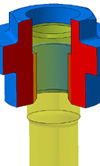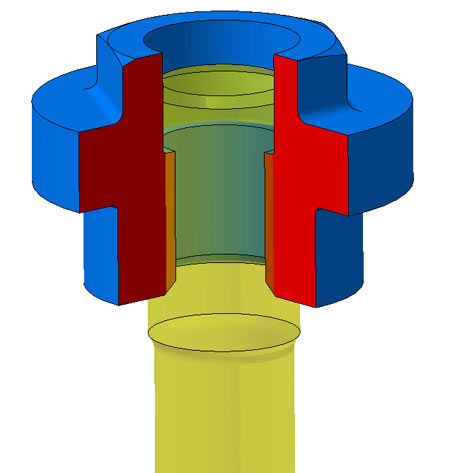Nuts: design for increased fatigue resistance
 Nuts are often given little consideration in design, especially compared to the stud onto which they engage. The reason is quite simple: nuts rarely fail unless they are completely unsuitable for the job. What is less commonly understood though is the fact that the nut design can have a critical effect on the fatigue resistance of the stud onto which it fits and the pre-load in which it is responsible for, in cases where stud failure coincides with the first loaded threads in the nut.
Nuts are often given little consideration in design, especially compared to the stud onto which they engage. The reason is quite simple: nuts rarely fail unless they are completely unsuitable for the job. What is less commonly understood though is the fact that the nut design can have a critical effect on the fatigue resistance of the stud onto which it fits and the pre-load in which it is responsible for, in cases where stud failure coincides with the first loaded threads in the nut.
There is much published material on the distribution of loads in the threads of nuts, and this has been referred to very briefly in a previous RET Monitor article, and also in the pages of Race Engine Technology magazine in a Focus article on fasteners.
The rest of this article will look at some aspects of nut design and material selection that have been studied by various engineers in the former USSR when working on fundamental research into the strength of threaded connections.
If we consider a stud and nut, the load path through the stud and nut requires that the lines of axial force are reacted at the thread flanks, and then the resultant compression and bending loads are returned immediately to the nut face. Improvements in stud fatigue life were noted by using two design methods - machining a groove into the washer face of the nut, and by employing a 'stepped nut'. Both methods have similar effects, and for the same two reasons.
First, the initial engaged threads are less stiff than those above. Given that the initial engaged threads commonly carry vastly more load than those further from the joint face, this promotes a more even distribution of load than in a conventional nut. Second, in each case, the load path is not turned so severely at the first thread, thus giving a lesser stress concentration factor. By employing a nut with a very narrow, deep groove in the face, the fatigue strength was increased by 30%, and improvements of between 18% and 30% were measured in the case where a stepped nut was used.

The manufacture of a grooved nut with a narrow, deep groove would not be easy for many of the small nuts generally used in racing, and the use of a stepped nut would not be practical in some circumstances owing to the increased space required.
In a separate experiment, two changes to the nut material were also found to have a significant effect on the fatigue strength of the stud. The first was to take the existing nut material and decrease its strength, in this case by using a normalising heat treatment. The second method was to use a material with a lower modulus than the existing steel nut. Compared to a geometrically identical nut, the normalised nut increased the stud fatigue strength by almost 6%. The use of a lower modulus nut material increased the fatigue strength of the stud by 40%.
Reference: Yakushev, A.I., "Effect of Manufacturing Technology and Basic Thread Parameters on the Strength of Threaded Connexions", Pergamon, 1964
Fig. 1 - A stepped nut, of the kind that gave a 30% improvement over a standard nut in a study by Birger in the former USSR. The flange is fitted uppermost
Written by Wayne Ward